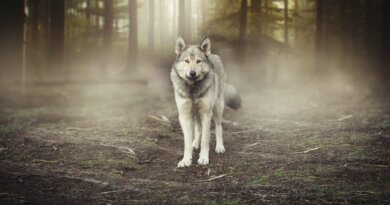What to Do if You See Coyotes While Walking Your Dog
Have you ever seen what you thought was a lost dog but, upon closer inspection, turned out to be a coyote? Coyotes are often encountered by those near wildlife reserves, forests, or farms—but that’s now changing.
Now more than ever, we must be aware of their increasing co-existence among humans in urban areas when walking alone or with our pets. However, it is important how we choose to coexist as coyotes are incredibly beneficial for our natural ecosystem. As omnivores, coyotes are our cities’ top predators, also known as “nature’s clean-up crew,” reducing the population of rodents and scavenging on dead animals.
The Eastern Coyote, North America’s “Song Dog” shares common DNA with the Algonquin Wolf. When left unhindered to thrive on their own, coyotes mate for life and have significant family bonds. Each family of coyotes maintains and defends a territory or home range that averages between 5 and 28 square kilometers (3 to 18 square miles), depending on food availability. They are skillful foragers who make use of a range of natural and human discarded food and waste.
With more of us enjoying outdoor activities to get our exercise and peace of mind during the pandemic, it is inevitable that we will cross paths with these majestic creatures, but it is essential to know what to do when it happens. If spotted in the distance, dogs will naturally raise their hackles and may show distressed body language when confronted with a coyote. Most commonly, dogs will bark and enter a protective mode, letting the coyote know to keep their distance.
GET THE BARK NEWSLETTER IN YOUR INBOX!
Sign up and get the answers to your questions.
Should you be scared if your dog barks at a coyote?
Dogs can smell and communicate with wildlife, including coyotes, via howling, barking, whimpering, sniffing, eye contact, and body language. Barking can pique a coyote’s interest, although it is more likely to scare it away after they notice a human is present. However, if your dog shows signs of eagerness to meet wildlife, try to distract with treats or change direction to reduce interaction and communication, preventing further escalation.
It is paramount to make sure your dog does not chase a coyote, as these canines see chasing differently. Ensuring a large distance between you and your dog and the coyote helps minimize the communication, thus making negative interactions more difficult.
If You Notice Coyotes in Your Neighborhood
Aversion conditioning is the process by which an unpleasant stimulus is paired with undesirable behavior and can be used as a peaceful technique to coexist with coyotes. Using these techniques can restore a coyote’s natural avoidance of humans and minimize direct interactions.
Reach out to your local fish and wildlife department for assistance if you notice an uptick in coyotes in your neighborhood. Depending on the family of coyotes, intensive and consistent action may be required to encourage them to move entirely. With that being said, the high intensity hazing of a coyote family should only be conducted by trained professionals with first-hand experience in these advanced techniques.
What to do if a Coyote is Approaching You and Your Dog
First and foremost, remain calm, keep eye contact, and slowly back away while leaving the area. Never run from a coyote, as you may trigger its predatory response and give it a reason to chase you. If you have any personal alarm devices such as a whistle, bell, or phone alarm, use them to scare or threaten the coyote.
- Stop and Stand Still
- Make Yourself BIG
- Be Loud and Assertive
- Slowly Back Away
- NEVER turn your back and run
Standing tall, making yourself look big, waving your arms, and shouting but not screaming while walking in the direction of the coyote until he or she runs away. Use a noisemaker such as your voice, a whistle, airhorn, banging pots and pans, filling a pop can with rocks, and shaking it, or snapping a large garbage bag, jingling keys, etc. These can all be very effective.
Always keep a safe distance. With coyotes that are accustomed to these techniques, it may take more than one of the above deterrents.
If the coyote decides to show aggressive behavior, remember to make yourself look big by raising your hands, stomping your feet, shaking your jacket, and making noise while shouting “Go Away!“
In the rare case, the coyote decides to continue to approach you, throw rocks or sticks in its direction but be sure NOT to hit the coyotes. Sticks, clumps of dirt, or tennis balls work well. Keep in mind that if you are walking with a small dog or your child, pick them up into your arms, giving the coyote less of a reason to continue to approach.
As owners of pets, we must:
- Clean up attractants: Bird feeders around the house attract rodents and small mammals, thus attracting coyotes, foxes, and birds of prey. Be sure to clean any fallen food or fruit from fruit trees. Do not leave pet food outside as it will attract unwanted wildlife. If you feed feral/wild animals, leave food out for 30 min, and then remove it. Keep all garbage in secured compost bins.
- No unsupervised roaming: Resist the urge to let your pets roam without supervision. Be sure to go outside with your dog at night to supervise them while they do their business. Coyotes and other wildlife can sneak into backyards for a meal.
- Keep all farm animals enclosed: Be sure to keep backyard farm life enclosed at night to protect them from visitors who like to dig under fences.
- Give wildlife their deserved space: Whether it is a squirrel, rabbit, or coyote, teach your dog to respect and not harass or chase wildlife.
- Keep your property clean: Remove big brush piles as they provide a perfect hiding spot for predators. Scoop your pup’s poop as pet feces attract rodents, who, in turn, attract larger wildlife. Keep all outdoor cooking areas clean. If you are living on a farm, dispose of dead stock quickly and securely.
- Avoid certain walking hours: Coyotes are most active during the hours of sunrise and sunset; be sure to keep your eyes open and be aware of your surroundings.
Remember that each animal placed on this earth plays a big role in the healthy maintenance of our natural ecosystems and the circle of life we humans depend on; we need them as much as they need us. Coyotes are a part of our urban communities and will remain that way. We have the chance to restructure our relationships with these urban canines while promoting a companionate co-existence.




buy prescription drugs from india: indian pharmacy online pharmacy india
buying prescription drugs in mexico online mexican mail order pharmacies mexican drugstore online mexicanpharmonline.com